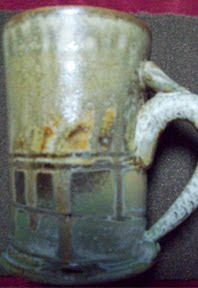 This year's show provided more woodworking than I have ever seen at the show, or any show in the area. It's like everyone got a lathe last Christmas. Not that there wasn't some lovely wood working, but oy vay was there a lot to choose from. Best part about all the wood workers, great dad gifts! I purchased from Bill Boyett of Gainesville Florida. His work included mostly boxes of exotic woods, however he had some beautiful letter openers. The letter openers are ergonomic in design and feel really good in your hand. And, any imperfections in the wood was inlaid with turquoise. Note the photo below, with the details of zebra wood and turquoise inlay. The second photo is on his show card. I wish he had had some of the letter openers that looks like the oak leaf on his card. They look lovely.
This year's show provided more woodworking than I have ever seen at the show, or any show in the area. It's like everyone got a lathe last Christmas. Not that there wasn't some lovely wood working, but oy vay was there a lot to choose from. Best part about all the wood workers, great dad gifts! I purchased from Bill Boyett of Gainesville Florida. His work included mostly boxes of exotic woods, however he had some beautiful letter openers. The letter openers are ergonomic in design and feel really good in your hand. And, any imperfections in the wood was inlaid with turquoise. Note the photo below, with the details of zebra wood and turquoise inlay. The second photo is on his show card. I wish he had had some of the letter openers that looks like the oak leaf on his card. They look lovely. My other purchase was a beautiful mug. It is "replacing" a mug I bought years ago and broke from the same artist, Steve Loucks. It's obvious that his MFA was earned from the New York College of Ceramics at Alfred (a.k.a. Alfred), one of the best ceramic schools in the nation. Notice the matt glaze with the shine glaze underneath and the alligator like glazing on the handle. It's a beautiful high fired piece. Lynnette, Steve's wife who sold me the piece, informs me that all of his pieces are sanded smooth on the bottom, a very nice finish. And, a good indicator of quality. I like his mugs because many have light colored interiors, muck better to gauge the intensity of my coffee and tea. And, I can tell if they are clean... for two very pragmatic reason. For aesthetic reasons, the glaze choices are sophisticated. And the proportions are great. His other works can be found online.


Ceramic purchasing tip: Always ask if the piece is high fire or low fire. High fire piece are stronger, the glazes are more durable and the pieces can be designed with thinner "walls". Important to know that lower fired works can be cheaper made and commonly craze in the glazing after a few uses and stain in the cracks. Good examples of low fire works come from shops like Bath and Body Works... cute, but poorly made.


Ceramic purchasing tip: Always ask if the piece is high fire or low fire. High fire piece are stronger, the glazes are more durable and the pieces can be designed with thinner "walls". Important to know that lower fired works can be cheaper made and commonly craze in the glazing after a few uses and stain in the cracks. Good examples of low fire works come from shops like Bath and Body Works... cute, but poorly made.
Please know that some mid-range and high fire glazes are designed to craze a part of the patterning of the glaze, but those will not cause you harm like cheaply made low fire pieces made in other countries. Really low fire pieces, like raku, are not designed to be functional, as in food safe. Many potters sell very low temp pieces (sometimes referred to as raku and pit fired) as dinnerware, but you should avoid it. Yes, people in ancient Japan used raku pottery to eat and drink from, but remember, as one point in European history, people used lead as a face powder. Those people died of lead poisoning. So, if you are not going to let your children chew lead paint and you're not going to install lead pipes for your drinking water, then don't buy raku to put food in.



No comments:
Post a Comment
Thank you for your comments! They will post as soon as they are moderated.